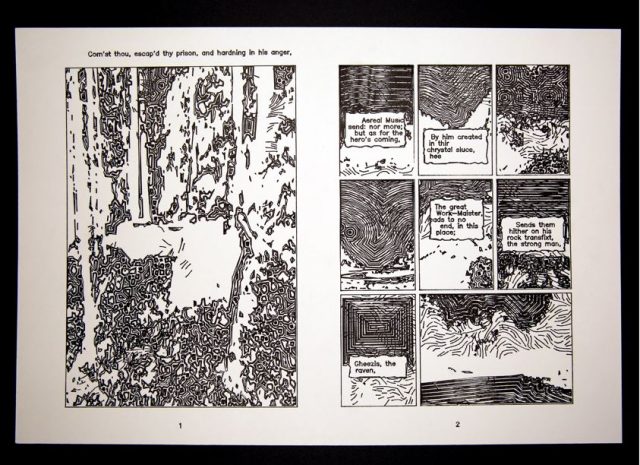
Full documentation images here!
[Text and additional images to be added soon]
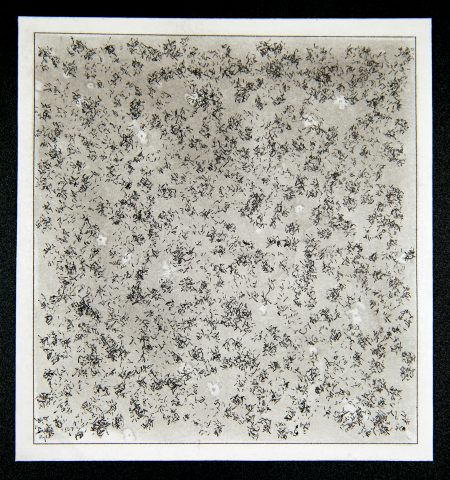
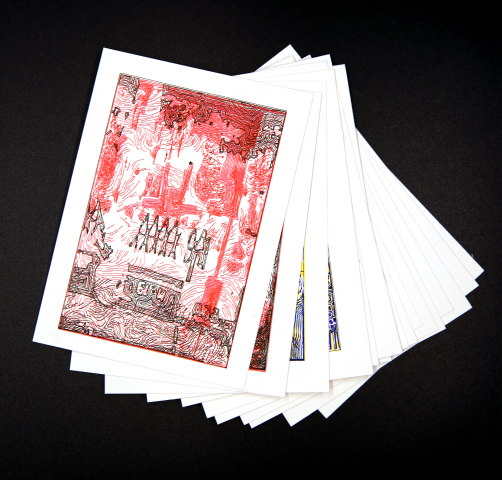
Drawing with Machines • 60-428
CMU School of Art / IDeATe, Fall 2021 • Prof. Golan Levin

For my final project, I have been exploring generative and experimental comic books.
How it started (previous work):

Inspiration:

Gareth A. Hopkins’ Experimental comics
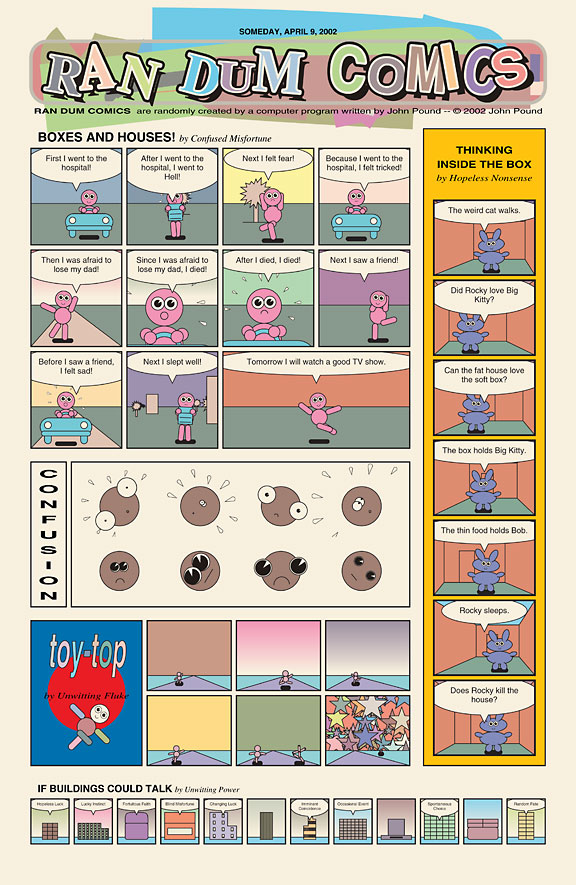
John Pound’s Generative comics.

Greg Borenstein’s generative detective comics.
Extra resources:
Friends, do you have any (artistic) references for algorithmically generated comics? (I know about: Kurlander's Comic Chat, Hanley's GANField, ComicGAN, etc.)
— Golan Levin (@golan) November 10, 2021
Full 10-page comic plotted:





Text Datasets: Text generation: Gutenberg Poetry Corpus by Allison Parrish.
Brief proposal:
For my final project, I want to explore generativity in prints and Latin American counterculture. In particular, I want to look at comics and editorial printmaking and illustration and I want to merge traditional drawing techniques (such as etching and screenprinting) with the computational and generative design that can be made with a plotter. I am especially interested in the interaction between the human and the machine and I want to narrow down my focus this semester to this.
Additionally, I am looking towards the option of scaling and reproducing my project to make small zines or editions of generative comics.
TLDR: I want to make generative comics that explore ideas of Latin American counterculture and heritage, but more importantly challenge mediums and explore plotting, etching, and other forms of printmaking and bookmaking. In this process, I will explore different generative writing methods and different material conditions to make my comics. As such, I anticipate my project being comprised of smaller tests and pieces that are part of a set as an exploration.
———————————————————–
Brief Sketch: Opted not to add a sketch since I still don’t know what I want the visual representation of my project to look like, however below I address some of my inspirations for this.
———————————————————–
Schedule:
11.03 Wed -- Proposal: Basic themes and idea
Due: #10 (Research/Proposal/Tests); DISCUSSION.
11.08 Mon -- Completed etching test print and updated "blob" code.
11.10 Wed -- Completed brainstorming of themes for final project comic and writing.
11.15 Mon -- Test prints.
11.17 Wed -- Test prints.
Due: #11 (Major Milestone); CRITIQUE.
11.22 Mon -- Test prints.
11.24 Wed -- NO SESSION (Thanksgiving).
11.29 Mon -- Start final prints + etchings.
12.01 Wed -- Due: #12 (Final Project); EXHIBITION.
———————————————————–
Previous work and inspiration:
In past semesters I have worked a lot with comics and generative text centering on Latin American studies, history, and language. I would like to bridge this area of my practice with physical mediums and genuinely generative writing.
Some of my comics:
Some of my previous generative writing:

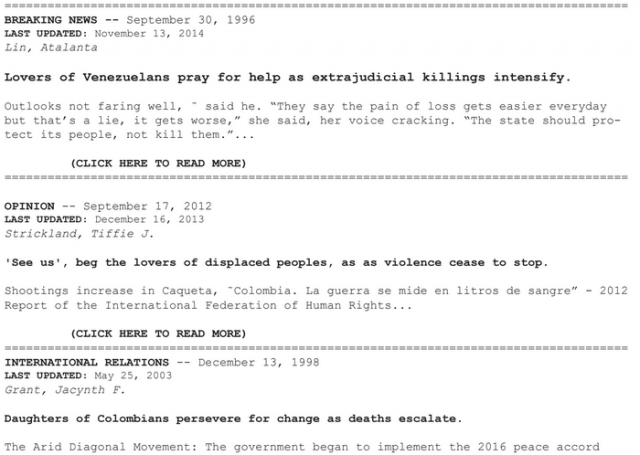
Some art that has been inspiring me:
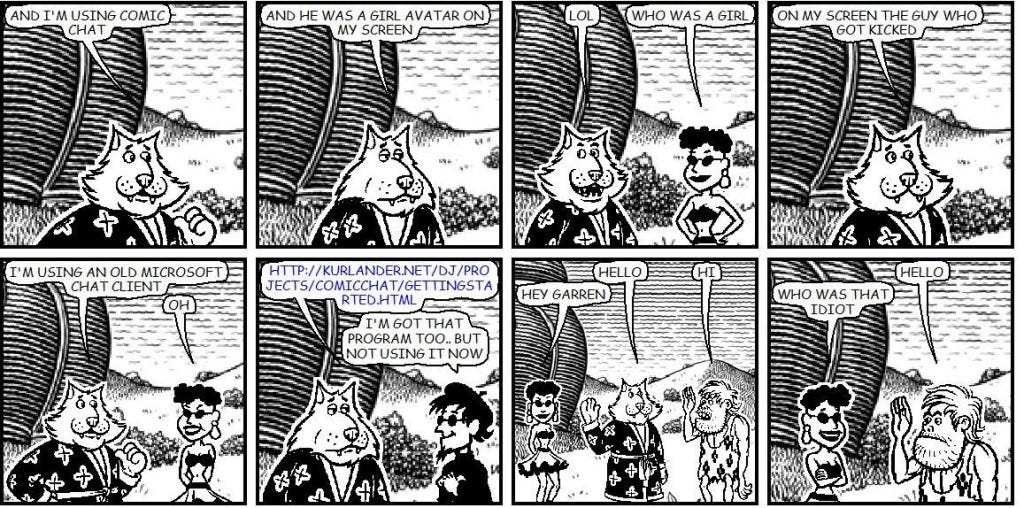
(Microsoft Comic chat)
(etched engraving art: Frank Stella)

(c: virus tropical by Powerpaola)
I have always been a huge fan of reaction-diffusion. Especially because I am a nerd so I’ve read a lot of papers that describe reaction-diffusion in chemical contexts. I really appreciated jasonwebb’s resources for it, because If I am honest, I don’t think I would’ve known when to start implementing it.
Hi.

So, I have been asking myself a lot of questions regarding the type of art I want to make with plotters. For one, I think that it’s been interesting how plotter interactions with manual drawing so far in this class have been limited to very little interaction with the actual plot itself. Things like coloring or small details have often been physical additions to the plot rather than full-on compositional drawn shapes.
I’ll be honest, I’ve been missing drawing a lot. So far, I feel like I haven’t had a genuine material connection with the work I am making and I often feel like I have to choose between drawing and computation, that is a feeling that I hate. So I wanted to explore the abstraction that exists in between the computationally generated pattern and how I, as an artist, interpret the hidden image within it and draw upon its attributes.
To get on to the technical background of the piece: I used reaction-diffusion and noise and randomness to make this piece. I think the most interesting things that came from this were the incremental elements of the reaction-diffusion and the use of randomness to make the shape fuzzy.

I always thought some of the rules in Cellular automatons often resembled Iberian tilings and thought it would be cool to do something like that. Also plotted animation is awesome and I wanted to give it a try.


I made an interface that allows me to modify the rules for the CA as well as the starting seed of the algorithm (including a random seed).


For those wondering how the pattern works, in essence, it utilizes a persistence effect and retains some of the cells from the previous iteration marked with a different pattern. This results in four total layers where each of the four patterns can be overlayed on top of each other.
 (off cell)
(off cell)  (on cell)
(on cell)
 (off*,1)
(off*,1) (off*,2)
(off*,2)
(off*, n)-> off, last on n frames ago.
Conway’s game of life + basic interface:

I added some of the pictures/themes I was considering in making this below. Obviously, not all of the pictures fit my idea in the final cut. But I experimented with a lot of these ideas. I originally started out by making hyperbolic tilings, which proved to be kind of annoying to implement given the timeframe though. I really like CA’s and tilings though, so I went with that.

Hello!
Ever thought of making comics with code? I sure did! Hence why I decided to make this my blob assignment 😀
(It’s blue because of VPype)
I really enjoyed doing this project, it felt like a fun throwback to drawing exercises and it made me think a lot about how materiality might connect with hatching and values. I wish I had utilized some more specific patterns, like the examples we saw in class with dithering or truchet tiles. But I was having too much fun with the patterns I had already chosen.
I also want to give attribution to Dan Schiffman’s video on the Hilbert Curve, which I adapted to create the fractal pattern in the first block.
Sketches:

First Iteration:
I really enjoyed looking through the DrawingBots server, in particular I enjoyed looking through the WIPs users posted and it made me contemplate a lot about the diversity of the crew making plotter art. I will not be including any images, in large part because I don’t find it appropriate to post someone else’s art from the server into a public post.
Observations:
1. Medium: It was rare to see a person use anything beside colored micron pens on white paper. There were a few that took advantage of inverse coloring. I really appreciate that many of the people in the community don’t necessarily come from the same background and I think its cool to note some of the general themes. Some people posted about hardware modifications or personal plotter designs, those WIPs were the ones I found most intriguing since it’s a domain so far from my own.
2. Hatching: I paid close attention to some lovely examples of hatching! Like sweetcorn previously mentioned, there is a tendency to stick to either spicy realism or super intense geometry in plotter art. Some of the more complex pieces of plotter art I observed fell into a mix of the two categories and what I really appreciated was the interesting patterns that were used for hatching (which seems to be the common trend in spicy realism).
One piece I particularly liked used voronoi diagrams, where the distance of each point was determined by the value and then these points were interpolated/randomized in a really weird way as to create a very nicely scribbled look to the drawing. The only reason I know voronoi was used was because I asked the person who made it. Very cool.
Another piece I liked used a very Van Gogh-esque field to define values and I noticed many others used complex geometric shapes at different points to create a value.
I feel like these responses often rely on highly mathematical properties to simulate real life, and I really respect that. But I also want them to maybe break it a little.